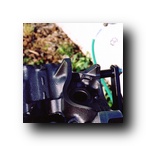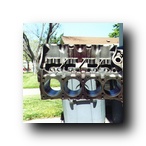* This text has been compiled to include only the various V8s that Pontiac manufactured, not the SOHC 6 cylinder engines, nor the 'corporate' V8s used in 1979 and later Pontiac vehicles...
One thing you will notice by looking at the various codes and applications charts on my site... Pontiac used the same two letter codes for various years, different displacements, and for different platforms. The info on this how-to page will attempt to show you the way to correctly determine what that engine in your garage, or in the junkyard, actually is. What I will try to do is inform you as to how the blocks were marked, then actually go through how to determine what the engine is (sometimes it is easier to learn with examples, right?)
The information that follows was collected through numerous web-sites and reading materials, so I cannot possibly give credit to all of those that contributed. If you recognize the pictures I used for illustration purposes, don't hesitate to let me know, and I will give them credit. Like I said, I have no idea where all of them came from. I am only a collector/organizer of info, not the creator.
The first item we need to tackle is making sure that it is actually a Pontiac block. The more obvious ways to do this would be to make sure the block you are looking at has a hydraulic lifter valley pan, as ALL Pontiac V8s have hydraulic lifters. Another quick item to check would be that the distributor is on a pad in the rear of the block, in a manner that would allow intake removal without distributor removal. Of course, just because your engine follows these two guidelines doesn't make it a Pontiac, but at least if it doesn't follow at least these two, then you would be in the wrong place to find info on it.
Now, we can get into how Pontiac marked their blocks through the years. Once you learn their methods, you should have plenty of information to decipher the year, engine displacement, and possibly what vehicle your block was originally installed in. You will notice that there are a lot of charts in this section. I only did that to be complete, but I am sure that it is not the cleanest layout possible. From all of the information I have gathered, it was all a jumbled mess. I tried to straighten it out in a manner that was understandable, but if I have failed at that, drop me a line with any suggestions on how to clarify it.
Ok, we either think or know that the block is a Pontiac,
so we need to check the block for identifying marks to determine it's displacement.
Pontiac used many methods and locations of marking their blocks (see chart
below), but two items were a mainstay. They never changed through the years,
so I will address them now.
We will first check to see if the block has the so-called 'transfer lug'. This is a piece of metal in the shape of a triangle or pyramid that sticks up off of the top of the block on the rear passenger side. If you have this transfer lug, you have a non-389/400 engine that dates 1959-present. 1959 and earlier blocks, of ANY displacement, did not have this transfer lug. There are two exceptions to this rule (like any other) and those are the 1961-62 421 Super Duty, and the 1973 Super Duty 455. I suppose they did not have this lug.
|
455 with the Transfer Lug |
1968 400 without the Transfer Lug |
I am not sure what the transfer lug is for, but have theorized (and not been corrected) that it was to aid in transporting the blocks from one machine to another during the manufacturing process.
The second trait that never went away was the use of a date code, which can be found on the distributor mounting pad, to the left of the distributor mounting hole. The date code consists of a letter that corresponds to the month of the year it was cast (i.e. A= January, B= February, etc.) and either two or three digits.
*NOTE: By the above pattern, 'L'= December. This is true except in the case of calendar year 1966 (model year 1967), where 'M' was used for December. I have yet to see a reason for this. However, it puts a crimp in the pattern, as 'H' or 'I' may be used to designate August, depending on what was used for January that year (or if one letter was skipped for some reason...?)
The first number following the letter (if there are 2 numbers) or the first and second number (if there are three) designate the day that the block was cast. And the last number is the year that the block was cast.
As an example... Let's say you have a WS coded block. That could be a '65 389, '66 389, '67 400, '68 400, '69 400, etc. Next you could look at the freeze plugs, which, if it has three on each side, would narrow the block down to the '67, '68, or '69. Let's just say it had three on each side, for this example. So, you have a WS coded 1967, 68, or 69 block. Well, looking at the possibilities, you can say that the block is a 400, but what year? Take a peek at the distributor mounting pad. You see the date code B098. This would translate to a block that was cast on the 9th of February, 1968. Keep in mind that this doesn't necessarily mean that it was installed in a 1968 car (if you are the numbers matching type). Due to the model year cycles, it could have been installed on a late 1968 car or an early 1969 car. That is where you would need to check (if your block is 1967 or later) the area around the timing cover, where Pontiac started casting the VIN into the block. There are many sources online for VIN decoding, so I would recommend starting there for more info.
Okay... in case you haven't noticed by cruising my Pontiac site, I am an avid fan of charts and tables. Sometimes it is so much easier to understand what is going on. This case is no different. During my searching for info, I noticed that a lot of texts had overlapping date ranges, and of course, there are blocks that are exempt from the regular rules. So, in that light, what follows is a table to show the different markings/identifying features of 1958-1978 Pontiac V8 blocks, without having to read and re-read endless text. Hopefully, it will help those that need a short guide to bring to the yard to identify that mysterious hunk-o-grease that they are getting ready to shell out for.
| Year | CID | Transfer Lug | Motor Mounts | Starter Provisions | Production Casting Number Location | Head Stud Oil Passages | Freeze Plugs | Additional Features |
| 1958 | All | No | No Side Mounts | Bellhousing | Passenger Side of Block | Yes | 2 per Side | None |
| 1959 | 389 | 2 per Side | Machined Notch on Passenger Side Deck, Where Head Meets Block | |||||
| 1960 | ||||||||
| 1961 | ||||||||
| 421 Super Duty | Machined Square Area on Passenger Deck, Where Head Meets Block | |||||||
| 1962 | 389 | See 'Notch' Above... | ||||||
| 421 Super Duty | See 'Square' Above... | |||||||
| 1963 | 326 | Yes | None | |||||
| 389 | No | See 'Notch' Above... | ||||||
| 421 | Yes | See 'Square' Above... | ||||||
| 1964 | 326 | Yes | Block Mount | Distributor Mounting Pad | None | |||
| 389 | No | See 'Notch' Above... | ||||||
| 421 | Yes | Passenger Side of Block | See 'Square' Above... | |||||
| 1965 | 326 | Yes | Distributor Mounting Pad | No | None | |||
| 389 | No | See 'Notch' Above... | ||||||
| 421 | Yes | See 'Square' Above... | ||||||
| 1966 | 326 | Yes | None | |||||
| 389 | No | See 'Notch' Above... | ||||||
| 421 | Yes | See 'Square' Above... | ||||||
| 1967 | 326 | Yes | Mid '67: Moved to Rear of Block (on top), Behind #8 Cylinder | 3 per Side | None | |||
| 400 | No | |||||||
| 428 | Yes | |||||||
| 1968 | 350 | Yes | ||||||
| 400 | No | |||||||
| 428 | Yes | '428' Between Freeze Plugs, '28' on Lifter Valley Rib | ||||||
| 1969 | 350 | Yes | None | |||||
| 400 | No | |||||||
| 428 | Yes | Displacement Marked on Side of Block, Between Freeze Plugs or in Front of Motor Mounts; Also, Lifter Valley Rib marked (i.e. '28'=428 or '50'=350) | ||||||
| 1970 | 350 | Yes | 5 Pads, Possible Only 3 Drilled and Tapped | |||||
| 400 | No | None | ||||||
| 455 | Yes | Displacement Marked on Side of Block, Between Freeze Plugs or in Front of Motor Mounts; Also, Lifter Valley Rib Marked (i.e. '00'=400, '28'=428, '50'=350, or '55'=455) | ||||||
| 1971 | 350 | Yes | ||||||
| 400 | No | |||||||
| 455 | Yes | |||||||
| 1972 | 350 | Yes | ||||||
| 400 | No | |||||||
| 455 | Yes | |||||||
| 1973 | 350 | Yes | ||||||
| 400 | No | |||||||
| 455 | Yes | |||||||
| 455 Super Duty | No | |||||||
| 1974 | 350 | Yes | ||||||
| 400 | No | |||||||
| 455 | Yes | |||||||
| 1975 | 350 | Yes | ||||||
| 400 | No | |||||||
| 455 | Yes | |||||||
| 1976 | 350 | Yes | ||||||
| 400 | No | |||||||
| 455 | Yes | |||||||
| 1977 | 350 | Yes | ||||||
| 400 | No | |||||||
| 1978 | 400 | No |


